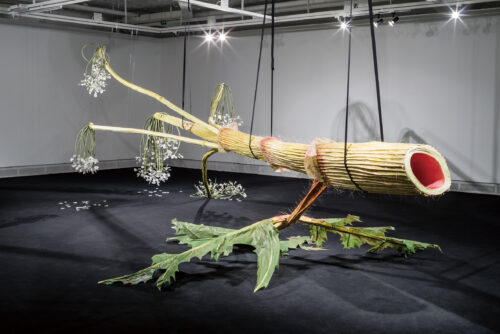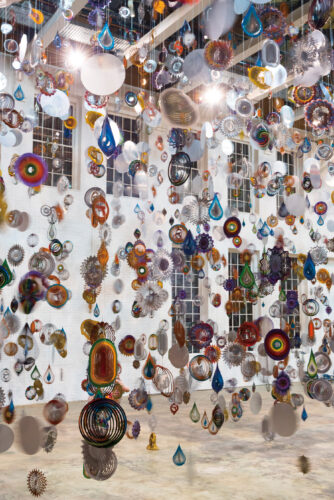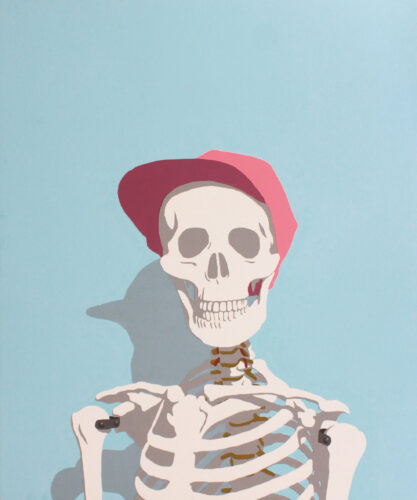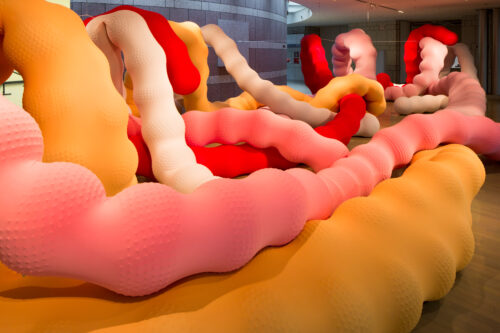By Saori Takeda
While major international art fairs around the world have decided to cancel or postpone one after another, Japan’s Yokohama Triennale 2020 opened in last July and successfully completed. About 70 artists’ works were on display at the main venue, Yokohama Museum of Art and other venues. Many of the works examine the idea of “living in symbiosis with the poisons that inevitably exist in the world”.
Tickets were available by reservation only; dates and times had been specified to avoid denseness. Admission was limited to visitors who were required to take a temperature test, disinfect and wear a mask. The artists were not able to come to Japan, so this show was able to exhibit most of the works through a remote installation.
The title of 7th Yokohama Triennale, which is held every three years, was “Afterglow”. The triennale was keen to introduce Asian artists, and the art direction was taken by the Indian trio Raqs Media Collective. They said, “In the course of a few months, a tiny virus, an un-living being, emerged, upending assumptions and assigning a task to the entire species. For the first time in human history we, all the billions from all parts of the world, have to undertake — in awareness of each other — there-making of forms of life. It has brought to the foreground the necessity of re-apprehending the world”.
Raqs Media Collective also said, “We are now in the afterglow of an unfamiliar, viral, and partly unreadable time, and are without familiar protocols. Alone, and collectively, we have to navigate the oscillation of scales, quickened by the alteration in familiar rules. We are now immersed in a turbulent flow whose pressure rides through us all. The is also a site: it is this exhibition where you walk through deliberations with artists, activating an auto-didactic impulse for the sensing and making of the spectrum that arches from our inner to our cosmic worlds. Autodidacts learn and un-learn everything. If necessary, they need to become misfits in relation to all that is given and taken for granted, because when all the functions and instructions that are written into the manual for fixing a world can’t be fixed, they must be altered”.
Of course, the theme of “coexistence with poison” was set before the Covid-19 crisis. It was a coincidence, so to speak. Mika Kuraya, director of Yokohama Museum of Art said, “Surprisingly, artists sometimes have this kind of ‘foresight’.
The participating artists presented their thoughts and answers in cutting-edge ways.
Chicago-based Nick Cave’s “Kinetic Spinner Forest”. Garden wind spinners, a common American garden decoration, were hung from the ceiling. The light sparkles like a big bang. In addition to the peace symbols, stars and smiling emoji, there were also spinners in the shape of guns and bullets. This work reminds us of the complex reality of American society. The forest glistens in the light from the ceiling, but it was somehow dark and poisonous. He is best known for SoundSuit, a detachable sculpture created as a response to the 1992 acquittal in the Rodney King case and the Los Angeles riots. Characterized by bright colors and rich ornamentation, Cave’s work raises questions about discrimination based on race, gender and social class.
Masaharu Sato was a Japanese filmmaker who died in 2019 at the age of 45. He painted a lot of paintings after doctors told him he had little time left to live. The exhibition featured his posthumous paintings, which were created using a technique similar to that of a rotoscope, which traced actual photographs. “Skull “ is an excellent work in which he made a character out of a skull that was placed in a hospital examination room to overcome the fear of death. Sato continued to draw familiar objects in his home during his illness, such as doorbell, electrical outlets, bathrooms, the night sky, and stairs. When Sato was painting stairs, he said, “There were 9 when I counted the stairs while painting this work. This marks the 9th work, since I started this series from last September. Every time I thought it might be the last one, so it is surprising even for myself, that I have managed this far. Aside that, I chose the stairs as motifs because of its stiffness, which doesn’t make a clatter after 60 years of age. I also admire the golden gleam of its solid wood surface, illuminated by the morning sun each season”.
Sato also said, “Among past, present, and future, I believe the present is the most important when a man faces death. You will fell only emptiness by just reflecting on the past, and you fell hopelessness if you imagine the future. Although it seems obvious, I just realized that enjoying the moment of ‘now’ is the best way of living”.
The Twin Trees (yellow)(blue), by Risa Sato of Japan. Risa is known for her public art that uses large soft sculptures. She considered the possibilities of communication through her works, appearing both indoors and outdoors in public spaces with large soft sculptures that were both abstract and intimate at the same time. There were also a number of collaborative productions through workshops. Visible from outside one of the main venues, Plot 48, the work conveyed a sense of openness and enclosure at the same time.
Kim Yunchul’s “Chroma” expresses the fusion of science and art. He is based in Incheon, South Korea. He is known for his mechanical three-dimensional works that apply scientific and mathematical theories. Chroma consists of hundreds of cells made of polymers, constructed based on mathematical knot theory to create a rich chain of colors. He was the winner of the Collide International Award 2016 by CERN (the European Organization for Nuclear Research) in Switzerland and FACT (Foundation for Art and Creative Technology) in the UK, which honors those who contribute to creative collisions between science and art.
Barcelona-born, London-based artist Eva Fàbregas’ “Tangles”. Fàbregas explored how the human body, desires and emotions were influenced by industrial design through large soft sculptures and installations that wrapped around the viewer’s body. Like a product for relieving stiff shoulders, the artist was interested in shapes and tactile sensations that were pleasing to the human body, and the art director had likened it to the human gut: “In the human gut, where a thousand trillion good and bad bacteria live together in symbiosis, I see a hint of ‘symbiosis with poison”.
“Giant Hogweed” by Sweden’s Ingela Ihrman.
Using plants and other living creatures as motifs, Ihrman created giant objects using craft- like methods and arranges them in theatrical settings to question the relationship between today’s natural environment and human society. In addition to exhibitions, she worked across a wide range of media, including performance, installation, writing, and stage design. 2019, she participated in Venice Biennale. The plant Giant Hogweed, native to Central Asia and imported to Europe in the 19th century for appreciation, was a beautiful plant, but its sap was highly phototoxic. Can we live in harmony with this beautiful poison?
“Citizens of the Cosmos”, a video work by New York and Berlin-based Russian-born Anton Vidokle. He is also the editor of the online art platform “e-flux” journal. One of his most recent masterpieces, a film trilogy centered on Russian Cosmism (2014‒2017), this video work focuses on “Russian Cosmism,” a bizarre idea that was seriously debated in the intelligentsia in the late 19th and 20th centuries. The idea that all deceased human beings should be brought back to life through science and technology, and that human beings should leave the cramped, overflowing earth and fly into space. Vidokle said, “While large sums of money are being spent on research in modern Western society to benefit the super-rich few who seek immortality, Russian cosmism is based on “ethics”. The idea is that all undeserved humanity, regardless of its place of birth or wealth, will be resurrected and create a utopia in the universe.
Yokohama Triennale 2020 tackled the difficult issue of coexistence with viruses and gave us a sense of hope.




